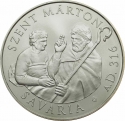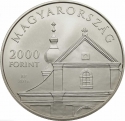You are about to finish your registration. Please check your mailbox (including spam folder). There should be a letter with a confirmation link. Check setting to make sure that your e-mail address is correct.
Send letter againDescription
Saint Martin of Tours (Latin: Martinus Turonensis; Hungarian: Szent Márton) was a Christian saint who lived during the 4th century AD, born around 316 in Savaria in the Diocese of Pannonia, now Hungary. He is one of the most revered saints in France and Europe, known as the patron saint of soldiers, horses, and France.
Martin was the son of a Roman military officer and served in the Roman cavalry in Gaul. A famous legend tells of him cutting his military cloak in half to share with a beggar, symbolizing his compassion. He left the military around 361 to become a disciple of Hilary of Poitiers and founded a monastery in Ligugé.
In 371, Martin became the third Bishop of Tours. As bishop, he was known for his missionary work, spreading Christianity, and his opposition to the violent persecution of heretics. His life was documented by Sulpicius Severus.
Martin's shrine in Tours became a significant pilgrimage site. His feast day, Martinmas, is celebrated on November 11th. His legacy was revitalized during the Franco-Prussian War, solidifying his status as a national symbol in France.
Engraver: Ferenc Lebó
Obverse

|
Depicts the scene of Saint Martin of Tours sharing his cloak with a beggar, framed in a stained glass window. At the bottom edge, the engraver's privy mark is located. Around the edge, in a circular inscription, the text "1700th ANNIVERSARY OF THE BIRTH OF SAINT MARTIN" is visible, with a decorative motif below. SZENT MÁRTON SZÜLETÉSÉNEK 1700. ÉVFORDULÓJA |
|---|---|
Reverse

|
Depicts an ancient Christian lamp hanger from Savaria, which can now be seen in the Savaria Museum in Szombathely. At the edge, the upper circular inscription reads "HUNGARY", while the lower circular inscription contains the denomination and the word "FORINT". The "BP." mint mark is situated on the left side, and the year of issue "2016" is on the right side, separating the two circular inscriptions. Under at least ten times magnification, microtext becomes visible within the mint mark. MAGYARORSZÁG |
| Edge |
10 000 Forint
KM# 910 Adamo# EM316
Related coins
1700th Anniversary of Birth of Saint Martin of Tours



